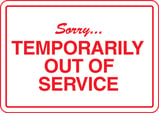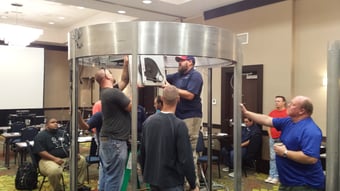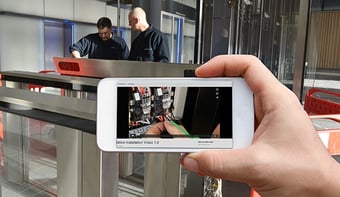Not long ago, a Philadelphia office tower installed two optical turnstiles in their main lobby that matched the building’s aesthetics beautifully. After a few years, however, one of the turnstiles stopped working and a part had to be ordered from Europe—with downtime estimated at four weeks. With only two optical turnstiles in their lobby, having one out of service was unacceptable. The owner immediately began looking into replacing the turnstiles.
 Elsewhere in Pennsylvania, a Pittsburgh hospital discovered that one of their security entrances was out of service. Management was shocked to find out that the nearest authorized service provider was more than eight hours away.
Elsewhere in Pennsylvania, a Pittsburgh hospital discovered that one of their security entrances was out of service. Management was shocked to find out that the nearest authorized service provider was more than eight hours away.
You’ve spent countless hours researching different security entrances – turnstiles, revolving doors, and access gates – how they are designed and how they work. But have you considered what will happen after they are installed? Who will you call, and how will they respond?
Before you purchase your new security entrances, consider these 6 service features that make all the difference to the overall success of your project.
(1) Pre-Installation Support
Security entrances are complex products that require accurate installation. Manufacturers should have a dedicated Installation Coordination team that communicates details related to preparing the job site with all of the parties involved (integrator, contractor, etc.), such as flooring requirements, conduit runs and manpower needs. The installation should be stress-free for the customer.
 (2) Installation Partner Training
(2) Installation Partner Training
Most manufacturers do not install their own entry products; therefore, they should be investing in training programs that equip installation technicians with the tools needed to guarantee success. Training should be offered in a variety of different formats to make it convenient for the trainee, including online webinars, hands-on factory training, regional roadshow training, and the like.
(3) Preventative Maintenance Services
An entrance solution requires continuous care to keep it running at its best. Preventative maintenance (PM) ensures that all parts are working correctly and keeps urgent service requests to a minimum. An experienced manufacturer will discuss annual or bi-annual PM service packages prior to the sale, as well as provide on-site training with the customer on daily maintenance routines.
(4) Interactive Troubleshooting Tools
An out of order entrance can lead to money loss, unhappy employees, potential security breaches and even costly guard employment. So, when an entrance goes down, you want to get it back in business as soon as possible. You’ll want a manufacturer who has interactive troubleshooting tools, as well as live assistance by phone, to help you problem-solve until a service technician can be on-site.
(5) Service & Parts Availability
If your security entrances need service, you’ll want to have a manufacturer who has technicians that are not only local, but trained and responsive. Parts availability is also extremely important. The difference between an entrance that is out of service for a day or weeks could come down to how quickly parts can be ordered and/or shipped.
(6) Technical Support
Should a service technician need assistance with troubleshooting an entrance, manufacturers should provide an in-house Technical Support team to answer phone calls and address questions from the field.
A security entrance should easily last 15 years or more - it is a true investment in the safety of your facility. And over time, it is the "soft feature" of service that ends up carrying the day, year after year, and creating the best payback possible for your organization.


